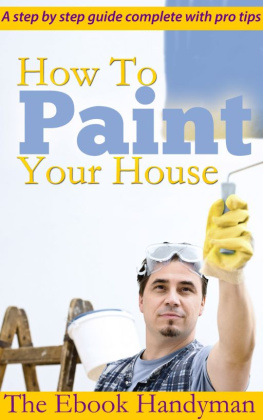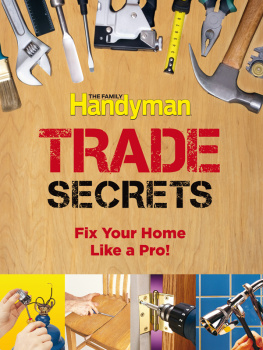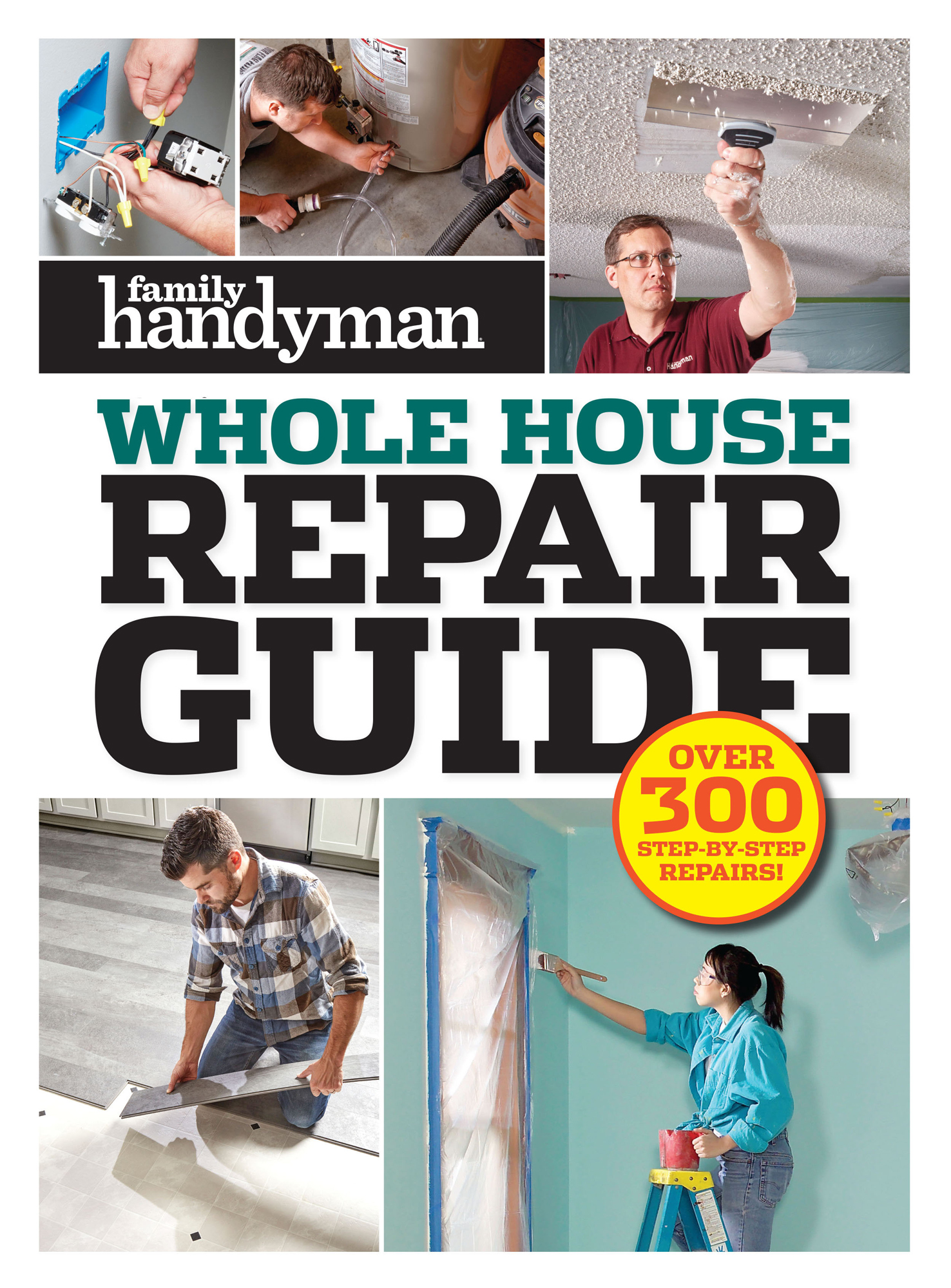Contents
Guide
Family Handyman Whole House Repair Guide
Over 300 Step-by-Step
Repairs!
A NOTE TO OUR READERS: All do-it-yourself activities involve a degree of risk. Skills, materials, tools and site conditions vary widely. Although the editors have made every effort to ensure accuracy, the reader remains responsible for the selection and use of tools, materials and methods. Always obey local codes and laws, follow manufacturer instructions and observe safety precautions.

Whole House Repair Guide
Project Editor Mary Flanagan
Cover Photography Tom Fenenga
Cover Art Direction Vern Johnson
Page Layout David Farr
Text, photography and illustrations for Whole House Repair Guide are based on articles previously published in Family Handyman magazine (2915 Commers Dr., Suite 700, Eagan, MN 55121, familyhandyman.com). For information on advertising in Family Handyman magazine, call (646) 518-4215.
Whole House Repair Guide is published by Home Service Publications, Inc., a subsidiary of Trusted Media Brands, Inc. 2021. All rights reserved. This volume may not be reproduced in whole or in part without written permission from the publisher. Family Handyman is a registered trademark of Trusted Media Brands, Inc.
Hardcover, dated: 978-1-62145-538-7
Hardcover, undated: 978-1-62145-554-7
Trade: 978-1-62145-539-4
Ebook: 978-1-62145-580-6
Family Handyman
Chief Content Officer Nick Grzechowiak
Editor-in-Chief Gary Wentz
Managing Editor Donna Bierbach
Associate Editors Bill Bergmann, Mike Berner, Jay Cork, Brad Holden
Creative Director Vern Johnson
Design and Production Mariah Cates, Jenny Mahoney, Andrea Sorensen
Photography Tom Fenenga
Illustrations Steve Bjrkman, Ron Chamberlain, Ken Clubb, Jeff Gorton, John Hartman, Trevor Johnston, Don Mannes, Christopher Mills, Frank Rohrbach
Set Builder Josh Risberg
Editorial Services Associate Peggy McDermott
Production Manager Aracely Lopez
Trusted Media Brands, Inc.
President & Chief Executive Officer Bonnie Kintzer
Safety first always!
Tackling home improvement projects and repairs can be endlessly rewarding. But as most of us know, with the rewards come risks. DIYers use chain saws, climb ladders and tear into walls that can contain big and hazardous surprises.
The good news is, armed with the right knowledge, tools and procedures, homeowners can minimize risk. As you go about your projects and repairs, stay alert for these hazards:
Aluminum wiring
Aluminum wiring, installed in about 7 million homes between 1965 and 1973, requires special techniques and materials to make safe connections. This wiring is dull gray, not the dull orange characteristic of copper. Hire a licensed electrician certified to work with it. For more information go to cpsc.gov and search for aluminum wiring.
Spontaneous combustion
Rags saturated with oil finishes like Danish oil and linseed oil, and oil-based paints and stains can spontaneously combust if left bunched up. Always dry them outdoors, spread out loosely. When the oil has thoroughly dried, you can safely throw them in the trash.
Vision and hearing protection
Safety glasses or goggles should be worn whenever youre working on DIY projects that involve chemicals, dust and anything that could shatter or chip off and hit your eye. Sounds louder than 80 decibels (dB) are considered potentially dangerous. Sound levels from a lawn mower can be 90 dB, and shop tools and chain saws can be 90 to 100 dB.
Lead paint
If your home was built before 1979, it may contain lead paint, which is a serious health hazard, especially for children six and under. Take precautions when you scrape or remove it. Contact your public health department for detailed safety information or call (800) 424-LEAD (5323) to receive an information pamphlet. Or visit epa.gov/lead.
Buried utilities
A few days before you dig in your yard, have your underground water, gas and electrical lines marked. Just call 811 or go to call811.com.
Smoke and carbon monoxide (CO) alarms
The risk of dying in reported home structure fires is cut in half in homes with working smoke alarms. Test your smoke alarms every month, replace batteries as necessary and replace units that are more than 10 years old. As you make your home more energy-efficient and airtight, existing ducts and chimneys cant always successfully vent combustion gases, including potentially deadly carbon monoxide (CO). Install a UL-listed CO detector, and test your CO and smoke alarms at the same time.
Five-gallon buckets and window covering cords
Anywhere from 10 to 40 children a year drown in 5-gallon buckets, according to the U.S. Consumer Products Safety Commission. Always store them upside down and store ones containing liquid with the covers securely snapped.
According to Parents for Window Blind Safety, hundreds of children in the United States are injured every year after becoming entangled in looped window treatment cords. For more information, visit pfwbs.org.
Working up high
If you have to get up on your roof to do a repair or installation, always install roof brackets and wear a roof harness.
Asbestos
Texture sprayed on ceilings before 1978, adhesives and tiles for vinyl and asphalt floors before 1980, and vermiculite insulation (with gray granules) all may contain asbestos. Other building materials, made between 1940 and 1980, could also contain asbestos. If you suspect that materials youre removing or working around contain asbestos, contact your health department or visit epa.gov/asbestos for information.
For additional information about home safety, visit homesafetycouncil.org. This site offers helpful information about dozens of home safety issues.
Chapter one EXTERIOR
Instant fixes for roof leaks
If you have water stains that extend across ceilings or run down walls, the cause is probably a roof leak. Tracking down the leak is the hard part; the fixes are usually pretty easy. Well show you some simple tricks for finding and repairing most of the common types of roof leaks. But if you live in the Snow Belt and in the winter you have leaks only on warm or sunny days, you probably have ice dams.

If running water doesnt reveal the exact location of the leak, dont be timid. Start removing shingles in the suspect area. With them removed, therell be evidence of the leak and youll be able to track it down right to the source. Youll see discolored felt paper or water-stained or even rotted wood directly below and around it.












